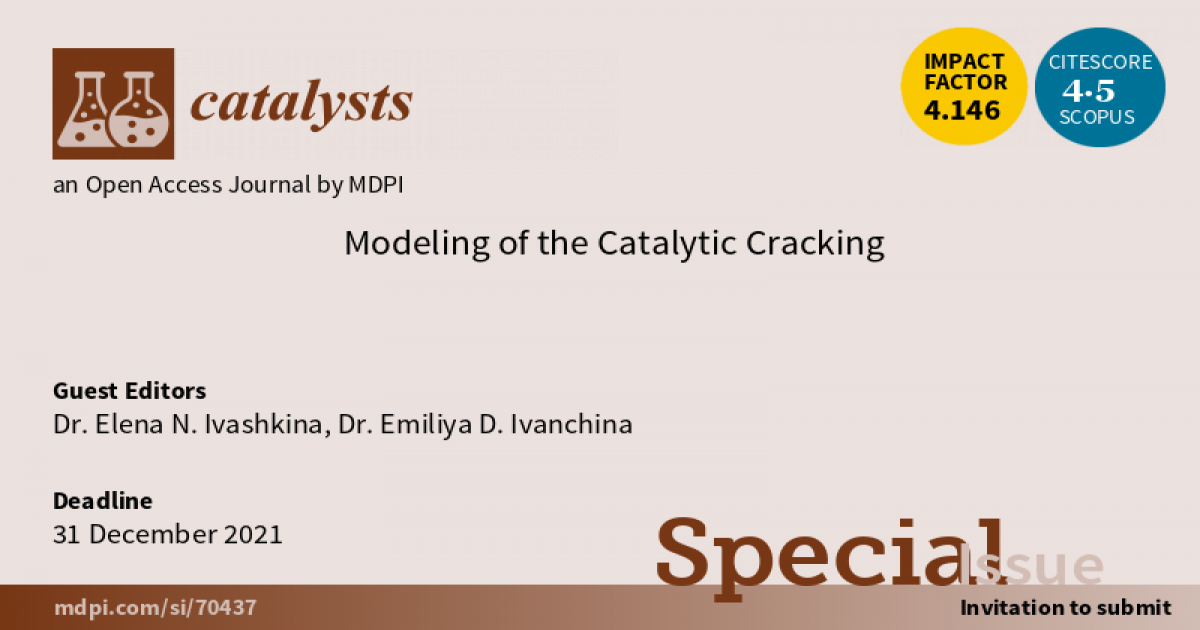- 4.0Impact Factor
- 7.6CiteScore
- 17 daysTime to First Decision
Modeling of the Catalytic Cracking
This special issue belongs to the section “Computational Catalysis“.
Special Issue Information
Dear Colleagues,
Significant efforts of the scientific community are focused on the development and optimization of processes and catalysts for the processing of heavy petroleum fractions, including catalytic cracking, which provides the production of about a quarter of the world’s gasoline stock. Along with an increase in the demand for motor fuel, the annual increase in demand for propylene is 5–6%; therefore, olefin-containing catalytic cracking gas, which is characterized by a high content of C3 and C4 hydrocarbons (25.1–35.8 and 31.3–38.00 % wt.) is valuable for the petrochemical industry.
At the same time, an increase in the catalytic cracking unit efficiency is complicated by changes in the feedstock composition and catalyst activity under the influence of coke and heavy metals, as well as the conjugation of the reactor and regenerator technological modes. Depending on these factors, the yield of the gasoline fraction is characterized by an extremum, which is associated with an increase in the rates of hydrocarbon cracking reactions, as well as condensation and coke formation reactions at high temperatures. Therefore, an urgent task in the catalytic cracking technology is to increase the yield of gasoline fraction with high octane characteristics and olefin-containing gas. This problem is especially urgent for units integrated with petrochemical plants.
To solve this problem, an integrated approach is required using mathematical models based on considering the thermodynamic, kinetic, and hydrodynamic regularities of the catalytic cracking of high molecular weight hydrocarbons, as well as the regularities of catalyst activity change under conditions of changing feedstock composition.
This Special Issue is devoted to modeling of the catalytic cracking. Reviews and original research papers are invited from experimental methods for studying the process and cracking catalysts, including topics from catalyst deactivation to simulations of industrial plants.
The potential topics include but are not limited to:
- Analysis of the current state and prospects of the catalytic cracking of petroleum feedstock;
- Modern technologies for catalytic cracking of crude oil;
- Modern catalytic compositions for the cracking of high molecular weight petroleum fractions;
- Modern concepts of the mechanism of hydrocarbon cracking on acid sites of catalysts;
- Deactivation of zeolite-containing cracking catalysts;
- Mathematical modeling of the catalytic cracking of petroleum feedstock considering catalyst deactivation;
- Modeling the process of catalytic cracking of petroleum feedstock based on kinetic schemes;
- Quantum-chemical modeling of the molecular structure, physicochemical properties, and reactivity of hydrocarbons in the catalytic cracking process;
- Thermodynamic laws of the catalytic cracking process;
- CFD modeling of lift reactors;
- Mathematical modeling of industrial technologies for catalytic cracking;
- Solution of multicriteria problems using the method of mathematical modeling on a physical and chemical basis taking into account the thermodynamics and kinetics of hydrocarbon reactions on the catalyst surface, as well as the unsteadiness of the processes due to coking, poisoning by harmful impurities in feedstock, and changes in the hydrocarbon composition of the processed feedstock.
Dr. Elena N. Ivashkina
Dr. Emiliya D. Ivanchina
Guest Editors
Manuscript Submission Information
Manuscripts should be submitted online at www.mdpi.com by registering and logging in to this website. Once you are registered, click here to go to the submission form. Manuscripts can be submitted until the deadline. All submissions that pass pre-check are peer-reviewed. Accepted papers will be published continuously in the journal (as soon as accepted) and will be listed together on the special issue website. Research articles, review articles as well as short communications are invited. For planned papers, a title and short abstract (about 250 words) can be sent to the Editorial Office for assessment.
Submitted manuscripts should not have been published previously, nor be under consideration for publication elsewhere (except conference proceedings papers). All manuscripts are thoroughly refereed through a single-blind peer-review process. A guide for authors and other relevant information for submission of manuscripts is available on the Instructions for Authors page. Catalysts is an international peer-reviewed open access monthly journal published by MDPI.
Please visit the Instructions for Authors page before submitting a manuscript. The Article Processing Charge (APC) for publication in this open access journal is 2200 CHF (Swiss Francs). Submitted papers should be well formatted and use good English. Authors may use MDPI's English editing service prior to publication or during author revisions.
Keywords
- catalytic cracking
- catalytic cracking reactors
- catalyst deactivation
- mathematical modeling
- predictive modeling
- deactivation non-stationary industrial processes of nanostructured catalysts
- hydrocracking
- hydrotreating
- dewaxing
- isomerization
- alkylation and reforming
- multi-criteria optimization

Benefits of Publishing in a Special Issue
- Ease of navigation: Grouping papers by topic helps scholars navigate broad scope journals more efficiently.
- Greater discoverability: Special Issues support the reach and impact of scientific research. Articles in Special Issues are more discoverable and cited more frequently.
- Expansion of research network: Special Issues facilitate connections among authors, fostering scientific collaborations.
- External promotion: Articles in Special Issues are often promoted through the journal's social media, increasing their visibility.
- e-Book format: Special Issues with more than 10 articles can be published as dedicated e-books, ensuring wide and rapid dissemination.

